Digital Devices and “in vivo” Imaging
PI: Prof. Chiara Cappelletto
Ph.D Candidate: Giulio Galimberti

The project aims 1) to contribute to research on digital issues, particularly with regard to in vivo visualization technologies, i.e., noninvasive and remote technologies that record our psychophysiological states and 2) to study the effects that images processed in this way currently have on the imagination of people, the news media, and social media, so as 3) to create a professional perspective between philosophy and engineering, capable of understanding human-machine interactions.
The development of medical imaging, in the fields of brain and fetal visualization, is setting up a new scopic regime whereby vision devices do not produce “operational images” (Harun Farocki, Eye Machine, 2001) so much as simulate vision through the collaboration of anatomical modeling, algorithms, and engineering solutions.
Such images make previously inaccessible neurobiological functions available to vision and synthesize a portrait of the human that until now has been not simply invisible or out of range, but entirely non-visual. This paradoxical “non-visual image” will be the theoretical and functional object of the inquiry. The research hypothesis builds on the claim that visualization devices are working alongside visibilization devices (J. Van Dijck, The Transparent Body. A Cultural Analysis of Medical Imaging, University of Washington Press, 2005; A. Prasad, “Making Images/Making Bodies: Visibilizing and Disciplining Through Magnetic Resonance Imaging (MRI),” Science, Technology, & Human Values 30 (2005): 291–316; K. Fedorova, “Neurointerfaces, Mental Imagery and Sensory Translation in Art and Science in the Digital Age,” in Invisibility in Visible and Material Culture, ed. A. Grønstad and Ø.d Vågnes, Palgrave Macmillan, 2019: 91–109; C. Cappelletto, The Labyrinth of the Self, Columbia UP, 2022).


As to the former, a particularly effective recent example is the use of the transmission electron microscope (TEM) to give a face to the SARS-CoV-2 virus, by taking its electronic fingerprint and then processing it computationally (R. Eugeni, Capitale algoritmico. Cinque dispositivi postmediali (più uno), Scholé, 2021). Although state-of-the-art, this technology belongs to the family of tools that enforce the realm of the visible (mirrors, lenses, photographic magnification, etc.).
Scanners used for magnetic resonance and thermal imaging cameras that detect, e.g., the stress of military pilots, work differently; both transform non-visual data into an image. The resulting family of optical artifacts has a very strong reality effect and a very strong communicative effectiveness, regarding which the scientific community itself has taken different positions (J. Dumit, Picturing Personhood: Brain Scans and Biomedical Identity, Princeton UP, 2004).
As demonstrated by many works from the most recent contemporary art, from Pierre Huyghe (UUmwelt, 2012) to Marina Abramovich (Measuring the Magic of Mutual Gaze, 2014) to Antoine D’Agata (I’m Starting to Feel the Pain, 2020), the impact of the modeling of imaging processes goes beyond the strictly medical field and augurs important repercussions in the areas of gaming, military technology, and more generally, in the collective political awareness of the truth status of the images we deal with and will deal with more and more in the years to come. The task of the PhD student will be to contribute to developing knowledge and know-how about how these images are produced and read through theoretical and applied research, and scholarly and lay publications.
To develop the specialized skillset, the selected applicant will spend two periods of study in research centers dedicated to digital images and will further train at the cutting-edge company NEXT2U, which produces thermal imaging cameras using smart IR thermal imaging and artificial intelligence.


